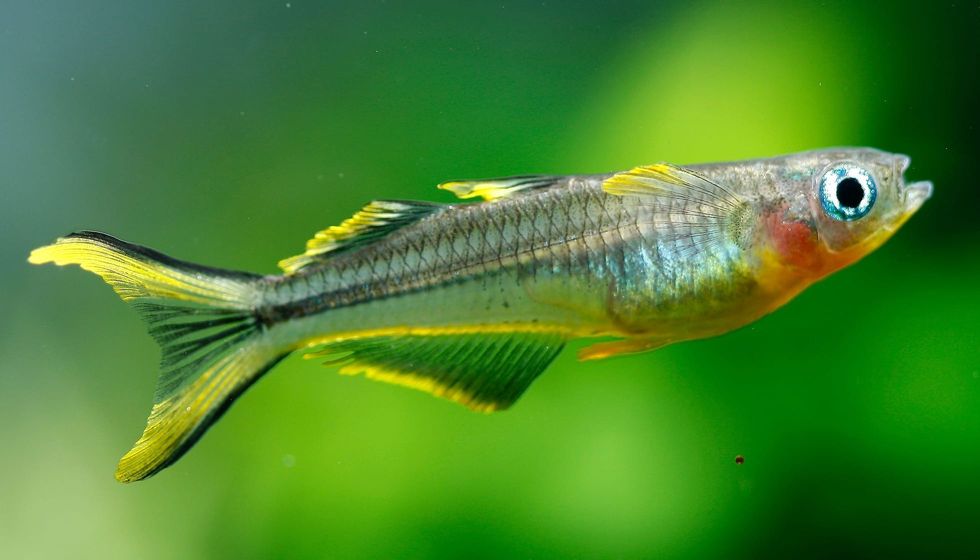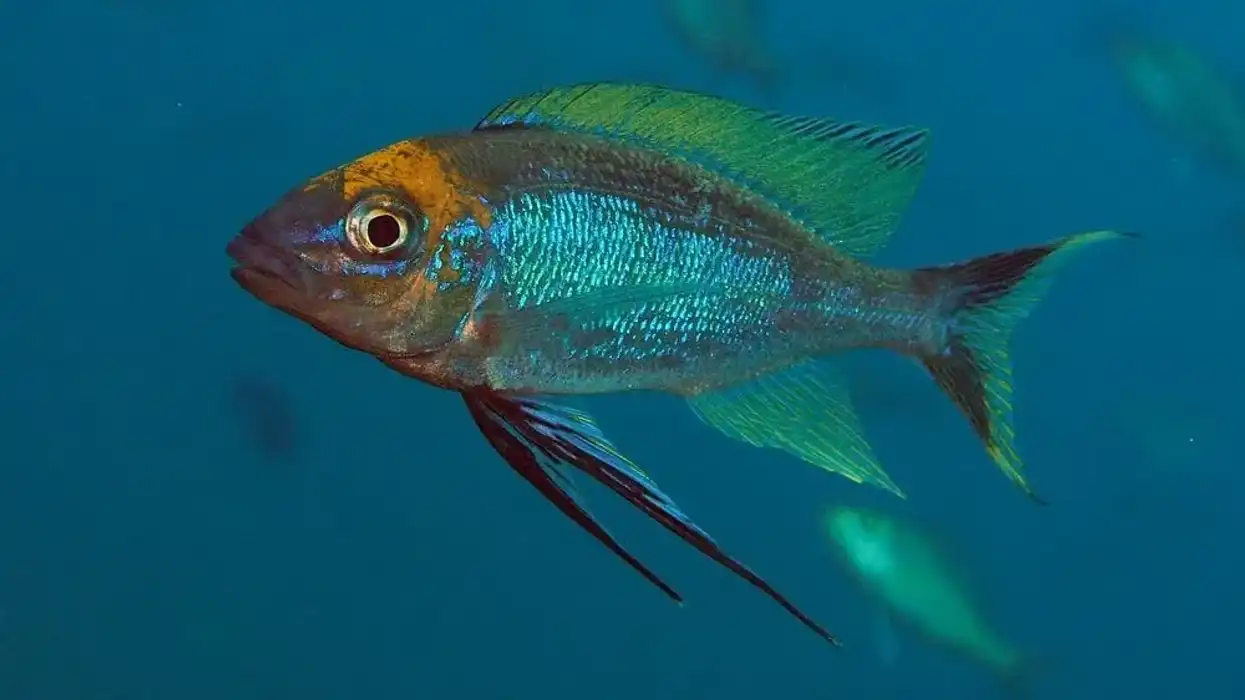With so many tank fish to choose from, there is one fish that stands out for its unique coloring and friendly nature. Yes, you guessed it, it is the fork tail rainbowfish!
More popularly called the forktail blue-eye, any list of tank fish would be incomplete without this little creature. Not only is it colorful enough to add a spice of color and vibrancy to your tank, but its aggressiveness is also virtually nonexistent. That means this fish will do well with almost every and any other fish.
While it is definitely a wonderful fish to have in a tank, there is much debate about its population. Usually found only in freshwater water bodies, its population has seen a steady decline in the wild.
However, conversely, there has been an increase in breeding this fish to meet market demands, meaning that while it is slowly becoming endangered in its natural habitats.
If you wish to know more about its population, how it came to be the way it is currently, and other important information about its diet, preferred water temperature, and more, then read on! Also, check out manta ray facts and stingray facts for more underwater facts.
Forktail Rainbowfish Interesting Facts
What type of animal is a forktail rainbowfish?
Pseudomugil furcatus is a type of fish.
What class of animal does a forktail rainbowfish belong to?
The forktail rainbowfish (Pseudomugil furcatus) belongs to the class Actinopterygii.
How many forktail rainbowfish are there in the world?
In the wild, just a few fork-tailed rainbowfish are found. They are domesticated for the aquarium trade since they are easy to propagate. As a result, blue eye rainbowfish estimated population is undetermined.
Where does a forktail rainbowfish live?
This freshwater rainbow-fish, forktail rainbowfish distribution varies rivers in Milne Bay Province into Papua New Guinea. From Collingwood Bay through Dyke Ackland Bay, these fish can be found. As aquarium species, forktail rainbowfish favor clean, densely planted rainforest rivers with a dark, coarse, stony, or sand substrate.
What is a forktail rainbowfish's habitat?
Forktail rainbowfish live in freshwater rivers.
Who do forktail rainbowfish live with?
These rainbow aquarium fish are calm and entertaining. They get on well with many other benign species.
How long does a forktail rainbowfish live?
Forktail rainbowfish life expectancy is roughly three years, even with excellent care. However, the tankmate of these fish, round goby, lives up to four years.
How do they reproduce?
For this species, breeding is a little different. To eliminate any shock difficulties, be sure to align the breeding tank's parameters. You can breed them in their main tank, but you can also create a special breeding tank.
In any case, make sure there are plenty of dense plants. Use breeding mops or feathery plants. Place them around the tank's perimeter.
Males will occupy plants on edge, while females will stick to the center. The males usually perform by swimming forth and back in the aquarium while maintaining an upright position for their dorsal fins, anal fins, and pelvic fins for the females at sunrise.
For breeding reasons, a densely planted aquarium with java moss or its similar is recommended. She'll eventually accompany one of the males home towards his plants and begin breeding with him.
They deposit eggs in little batches over a period of weeks or days. Keep a close eye out for these eggs and transfer them to a different tank. If given the opportunity, adult males or females will try to devour the eggs. Individual eggs can get smaller as the female proceeds to lay bunches of eggs until she's finished.
The hatching of eggs depends on the water conditions. You can start feeding them baby brine shrimp and powdered dry food right away. Six times a day, feed little portions of varied frozen foods. With patience and careful dedication, they'll be around an inch long in three months.
What is their conservation status?
Their conservation status is of Least Concern according to the IUCN Red List.
Forktail Rainbowfish Fun Facts
What does forktail rainbowfish look like?

The body of the forktail blue eye fish is fashioned like a torpedo. The fins are what give the forktail rainbowfish its unique shape. The spiky dorsal fin is tiny and modest.
A bigger floppy dorsal fin, however, is present. It has a squared-off shape and stretches all the way to the tailfin.
On the base of the body is an anal fin with a similar form. The pectoral fins, on the other hand, are upturned. The fins provide a wing-like look that is unlike anything you've ever seen in a freshwater fish.
The forktail blue-eye fish is also really colorful! Silver-gray, including a greenish hue, is the main body color. Bright yellow accents can be found throughout the body. Subtle black stripes accompany the yellow. The brilliant blue eyes of the rainbowfish are its ultimate distinguishing feature!
How cute are they?
It is an attractive and relatively cute fish.
How do they communicate?
The communication methods of forktail blue eye fish, located in Eastern Papua New Guinea, are unknown. Redtail catfish generate a clicking noise that wards off predators and warns their fellow species.
Their whiskers or barbels have chemical receptor cells that help them to smell better. These barbels recognize the chemoreceptors left behind by some other catfish in the food search.
How big is a forktail rainbowfish?
Forktail rainbowfish size measures between 2-2.4 in (5-6 cm). However, rainbow cichlid aquarium fish length ranges around 3 in (7.62 cm). Therefore, comparing both tank fish, the forktail rainbowfish is smaller than the cichlid.
How fast can a forktail rainbowfish swim?
The tank fish forktail blue eye rainbowfish is extremely active, not just swift but also agile, swimming, twirling, and rotating in or out of plants with abandon.
How much does a forktail rainbowfish weigh?
The weight range of these small rainbowfish (Pseudomugil furcatus) aquarium species is undescribed.
What are the male and female names of the species?
There is not any special name for males and females species of forktail blue eye tank fish.
What would you call a baby forktail rainbowfish?
There is no specific name for the baby rainbowfish.
What do they eat?
Forktail rainbowfish, when it comes to food, aren't choosy. They'll eat almost anything and have no restrictions on their diet. As the foundation of the forktail rainbowfish diet, you can supply normal nutritious foods dry flakes. As a complement, serve live or frozen foods snacks. Brine shrimp, daphnia, and cyclops are foods, which can add to their diet.
Are they aggressive?
These aquarium species belonging to Eastern Papua New Guinea are not aggressive, although they are fin nippers in some cases.
Would they make a good pet?
Forktail blue-eye is noted for producing a dazzling display of color in a home aquarium due to its playful and peaceful temperament. They're a lot of fun to look after and are simple enough for even the most inexperienced fish enthusiasts to maintain.
At the absolute least, forktail blue-eye requires a tank size with a capacity of a minimum of 20 gal (90.9 L) for one tiny group of fish. Freshwater fish require a lot of swimming room. Their natural habitat includes slow-moving waters that are bordered by vegetation.
The forktail blue eye rainbowfish isn't fussy about the water conditions. It can adapt to a variety of water conditions.
Water temperature should be between 75-79 F (23.8-26.1 C), and the pH level should be about 7.6 for the healthy growth of these blue eye rainbowfish. Because these fish thrive in groups, it's critical to keep at least six of them together.
Tankmates must be tiny and peaceful, and they should share the same water temperature and conditions. Smaller goby or catfish species and other little rainbowfish, and several petite cyprinids could be tankmates. Because the forktail rainbowfish prefer the intermediate to higher levels, little bottom-dwelling catfish or gobies work particularly well.
These tank fish prefer a planted aquarium with feathery vegetation. These rainbow fish thrive on fine-leaf aqueous moss and floating plants having deep roots. Then choose a lid that is sturdy and secure. These fish are notorious for jumping out from the water and drowning.
Feed only as often as the fish could consume in two minutes. To maintain the water conditions, eliminate overfeeding. Having too much more food inside the water can cause major issues.
Did you know...
The Kwagira River and Peria Creek and in eastern Papua New Guinea is the forktail rainbowfish's range. Slow-moving rivers with dense vegetation are ideal for these fish because they can easily access their favorite diet: phytoplankton, zooplankton, as well as invertebrates.
Are forktail rainbowfish aggressive?
No, this rainbow (Pseudomugil furcatus) is not an aggressive species. Instead, these tank fish are peaceful, easy to keep, and beautiful to look at.
How many forktail rainbowfish should be kept together?
It's critical to maintain a group of at least six blue-eye rainbowfish or forktail blue-eye together. The majority of the time, solitary rainbowfish will hide. They may even lose their color.
Here at Kidadl, we have carefully created lots of interesting family-friendly animal facts for everyone to discover! For more relatable content, check out these giant guitarfish facts and giant frogfish facts for kids.
You can even occupy yourself at home by coloring in one of our free printable forktail rainbowfish coloring pages.










